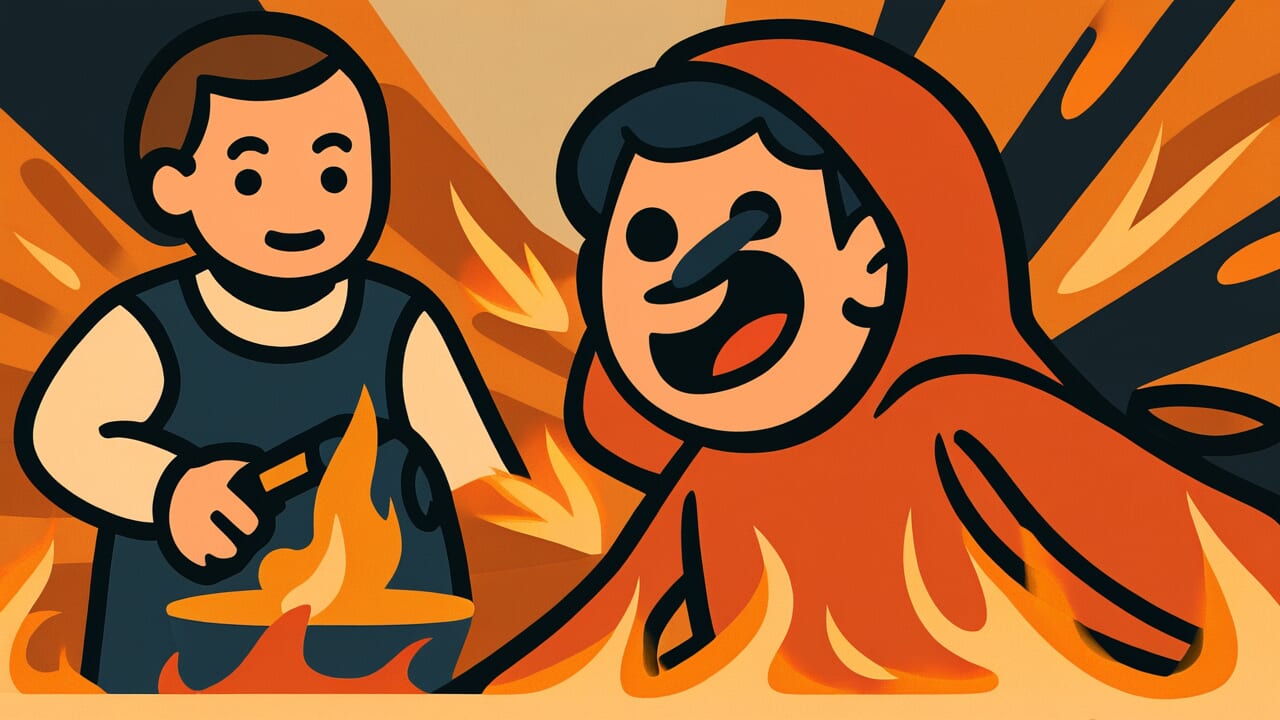How to Read “Fire calls fire”
Hi ga hi wo yobu
Meaning of “Fire calls fire”
“Fire calls fire” is a proverb that describes how one action or event attracts another action or event with similar qualities. The situation then expands and grows continuously.
Just like fire spreads, things of the same kind attract each other and amplify in a chain reaction.
This proverb is used when one action triggers similar actions, whether good or bad, and the situation develops rapidly.
For example, when one person expresses anger, others around them become emotional too, and the conflict escalates. Or conversely, one person’s kindness inspires kindness in others, and a circle of cooperation spreads.
In modern times, this proverb’s meaning becomes even more relatable in our society where information spreads instantly. Think of social media controversies or positive movements going viral.
This proverb shows the sharp observation of our ancestors. They compared the essential nature of human society to fire, a familiar phenomenon. Things with the same energy resonate with each other and amplify.
Origin and Etymology
There are no clear written records about the origin of “Fire calls fire.” However, we can make interesting observations from the structure of this phrase.
First, notice the verb “yobu” (calls). This isn’t just a simple “call.” It means to raise your voice with strong intention to summon something.
By applying this human action to fire, an inanimate object, the phrase creates the impression that fire has its own will to summon its companions.
When we observe the nature of fire, we can see the background of this proverb. As fire spreads, it moves from one flammable object to another. A small spark can develop into a massive blaze.
At fire scenes, rising heat creates updrafts that supply fresh oxygen, strengthening the flames. It truly looks like fire is calling more fire.
Japan has historically centered on wooden architecture, and has a long history of fighting fires. As the saying goes, “Fires and fights are the flowers of Edo.”
Fires broke out frequently, especially during the Edo period. People knew the terror of fire firsthand. They witnessed how one fire would call others of its kind and burn down entire towns.
This expression likely emerged from such experiences.
Usage Examples
- His aggressive remarks triggered anger in others like fire calls fire, and the meeting became uncontrollable
- One person’s smile spread a cheerful atmosphere throughout the team like fire calls fire
Universal Wisdom
The proverb “Fire calls fire” brilliantly captures the principle of resonance and amplification in human society. Why has this phrase been passed down for so long?
Perhaps it’s because humans are fundamentally “creatures who seek their own kind.”
We are not isolated beings. One person’s emotions and actions always ripple outward to others. Anger calls anger, fear calls fear, and joy calls joy.
This isn’t just theory. It’s a fundamental human trait. We resonate with others’ emotions and unconsciously synchronize with them.
The deep truth this proverb reveals is the importance of the first “fire” we ignite. Like a small spark becoming a great blaze, your single word or action can trigger a chain reaction around you.
Eventually, it creates a large current. It can become a destructive flame or a hopeful light that warms people.
Our ancestors feared the power of this chain reaction, but they also recognized its potential. That’s why they emphasized the importance of carefully choosing the first step in this proverb.
What kind of fire will you light today? That choice has the power to shape the future.
When AI Hears This
When we analyze how fires spread using mathematical models, remarkable patterns emerge. One burning tree alone won’t cause a forest fire.
But once a certain density is exceeded, fire consumes the entire forest. We call this boundary the “critical point.”
What’s fascinating is how dramatically fire spreading changes before and after this critical point. If forest tree density is 59% or below, fire naturally dies out.
But above 60%, it spreads in a chain reaction. Just a 1% difference separates containment from catastrophe. Mathematics explains this through “percolation theory.”
Even more noteworthy is that the burning area increases proportionally to the square of time. If 10 square meters burn in the first minute, 40 square meters burn after 2 minutes, and 90 square meters after 3 minutes.
It accelerates exponentially. This is a positive feedback loop. Fire creates heat, and heat creates new fire.
This self-amplification mechanism can describe information spreading on social media using the same mathematical formula.
Before crossing the critical point, one bucket of water could extinguish the fire. After crossing it, even 100 fire trucks can’t control it.
This proverb verbalized the terror of systems undergoing phase transitions hundreds of years before science discovered it.
Lessons for Today
“Fire calls fire” teaches modern people about the magnitude of influence from the first spark you create. A casual social media post, a morning greeting at work, your attitude toward family.
All of these become sparks that create chain reactions around you.
Modern society is more interconnected than ever before. Your actions spread faster and wider than you imagine. That’s why it’s crucial to consciously choose what kind of fire you light.
The fire of criticism and negativity quickly causes things to go up in flames. But the fire of gratitude and encouragement spreads just as powerfully.
This proverb isn’t forcing responsibility on you. Rather, it’s teaching you that you have the power to change the world.
A small kindness lights a fire in someone’s heart. That person then delivers kindness to someone else. This creates a warm chain reaction.
What kind of fire will you light today? That choice gradually shapes tomorrow’s world.



Comments